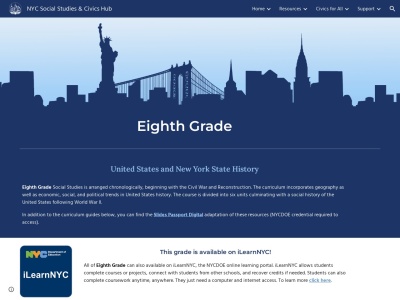前回のトピックに引き続き、今日は継承日本語話者への戦争教育について書いてみようと思います。前回は、日本語補習校で使われている教科書で戦争がどのように導入されているかを書いたので、今回は、アメリカの学校(ニューヨーク市の公立学校)で戦争がどのように扱われているかをまとめてみようと思います。
まず、最初に、アメリカの公立初等教育のシステムについてですが、 日本の公立初等教育が「教育指導要領」に沿って作られた教科書を使用して指導要領に沿って、日本のどこでも同じカリキュラム使って教えるという中央集中性なカリキュラムなのに対し、アメリカは学校教育における中央の連邦政府の役割と、地方の政府や教育機関の役割が別れており、日本と比べると、地方の政府や教育機関の役割が高いと感じます。これはアメリカは連邦政府制なので、教育だけではなく、司法や行政などにおいても中央政府と地方の政府のそれぞれに役割が分担されているので、特にアメリカの教育システムが前衛的であるというわけでは無いのですが、地域の特色や教育を受けている人たちのバックグラウンドなどを考慮してカリキュラムが作成できるようになっています(他方で、教育を受ける場所によって違った教育カリキュラムを使うのは平等性に欠けるという欠点もあります)。今回は、ニューヨーク市の公立学校のカリキュラムで、戦争がどのように扱われているかを調べたのですが、ニューヨーク市はアメリカでも非常に前衛的な場所であり、またニューヨークを含む東海岸には、イタリア系、ドイツ系アメリカ人のいわゆる第二次大戦中のthe Axis (枢軸国)にルーツを持つアメリカ人も多くいるので、そう言った人口統計的な要素もカリキュラムに反映されているかもしれません。
ニューヨーク州のSocial Studiesのカリキュラムで、第二次世界大戦が扱われるのはGrade 8 (中学三年)の最後のユニットの Grade 8 Unit 6 “America After World War II: The Changing Nature of the American People”です (https://sites.google.com/schools.nyc.gov/social-studies-and-civics/resources-by-grade/middle/8th-grade)。一応、”Passport to Social Studies”という教科書のようなものがあるのですが、日本の授業と違い、先生方の裁量で教材を開発して授業を進めるので、この教科書で授業が教えられるということではないです。自分の子供が通っている学校の先生方の感じですと、大体の先生は、まあ教科書も使うけれども、半分くらいは自受開発の教材で教えるような感じの先生が多いように感じます。カリキュラムで規定されている目標が達成されれば、教科書を使うかどうかは先生の判断に任されているわけです。
ですので、日本では歴史教育に「どの教科書が使われるか」という議論が多いのですが、アメリカの学校では、どのようなカリキュラムが規定されているかということを考えないといけません。2025年現在での、ニューヨーク州のSocial Studiesの8年生のカリキュラムは、”NYS K-8 Social Studies Framework – March 2016″ (https://www.nysed.gov/standards-instruction/social-studies)で、そこでは、第二次世界大戦に関するカリキュラムは以下のように規定されています (ニューヨーク州のカリキュラムには、全学年を通じたStandardsというものと、それが学年ごとに詳しく細分化されたFrameworksというのがあるのですが、以下のものはGrade 8のFrameworkです。)。
- 8.6 WORLD WAR II: The aggression of the Axis powers threatened United States security and led to its entry into World War II. The nature and consequences of warfare during World War II transformed the United States and the global community. The damage from total warfare and atrocities such as the Holocaust led to a call for international efforts to protect human rights and prevent future wars. (Standards: 1, 2, 3; Themes: TCC, GOV, TECH, EXCH)
- 8.6a Worldwide economic depression, militant nationalism, the rise of totalitarian rule, and the unsuccessful efforts
of the League of Nations to preserve peace contributed to the outbreak of war in Europe and Asia.- Students will examine how the worldwide economic depression and militant nationalism resulted in the rise of totalitarian rule.
- 8.6b From 1939 to 1941, the United States government tried to maintain neutrality while providing aid to Britain but was drawn into the war by the Japanese attack on Pearl Harbor. The United States fought a war on multiple fronts. At home, the economy was converted to war production, and essential resources were rationed to ensure adequate supplies for military use.
- Students will examine American involvement in World War II, including the American strategy in the Pacific and the invasion of Normandy on D-Day.
- Students will examine the role of the Tuskegee Airmen within the segregated military during World War II.
- Students will investigate the effects of the war on the American economy and day-to-day life.
- Students will examine the internment of Japanese Americans in light of perceived national security concerns versus constitutional rights, including the decision in Korematsu v. United States (1944).
- Student will examine the role of New Yorkers in World War II, focusing on local institutions, such as the Fort Ontario Refugee Center or the Brooklyn Navy Yard.
- 8.6c The nature and consequences of warfare during World War II transformed the United States and the global community. The damage from total warfare and human atrocities, including the Holocaust, led to a call for an international organization to prevent future wars and the protection of human rights.
- Students will examine the role of air power by the allies, including the use of the atomic bombs on Hiroshima and Nagasaki.
- Students will investigate the Holocaust and explain the historical significance of the Nuremberg trials.
- Students will examine the structure and work of the United Nations.
- 8.6a Worldwide economic depression, militant nationalism, the rise of totalitarian rule, and the unsuccessful efforts
上記のようなことを考察して、あくまで個人的な意見ですが、ニューヨーク市での公立学校での第二次世界大戦に関する歴史教育についての考えをまとめてみました。
- アメリカの歴史上、第二次世界大戦はヨーロッパ戦線を中心に語られることが多い(D-DayやHolocaustなど)。日本が関連してくるのは、真珠湾攻撃(「アメリカは内政重視の政策だったので、ヨーロッパでの極右主義の台頭には傍観方針だったのが、真珠湾攻撃で日本とその同盟国であるドイツとイタリアとの開戦となった」というような内容)、広島と長崎への原子爆弾投下(「第二次世界大戦時には、航空機や潜水艦など多くの兵器が開発され、最終的に原子爆弾の開発となった」というような内容)のみ。
- 日本に関連する事項は思ったよりもかなり少ない。他方で、日系アメリカ人の強制収容所など、アメリカの人権や人種に関するトピックは含まれていて、どちらかというと日本の第二次世界大戦の歴史における意義は、アメリカの人権に関するトピックに移っている。
- おそらく、一般的なアメリカ人の第二次世界大戦のイメージはヨーロッパ戦線であり、公立学校の歴史教育でも、第二次世界大戦の日本の立場やアジア戦線のことは多くは語られないのかと思う。紹介されるのはアメリカの第二次世界大戦参戦の機会となった「真珠湾攻撃」と「原子爆弾」くらいで、それらも「日系アメリカ人の強制収容所」に移り変わっている感じ。
- アメリカの学校では、第二次世界大戦時の日本が、ドイツのナチズムやイタリアのファシズムと同様に教えられているのではないかと疑問に思い、いろいろ調べてみたが、よくも悪くも、アメリカの第二次世界大戦に関する歴史教育では、日本のことは語られない。アメリカの歴史教育は、ヨーロッパ中心の歴史だと感じる。日本の負の歴史が語られないことはいいことなのか、あるいは、歴史に存在しないように語られないのは悪いことなのかは疑問に思う。

